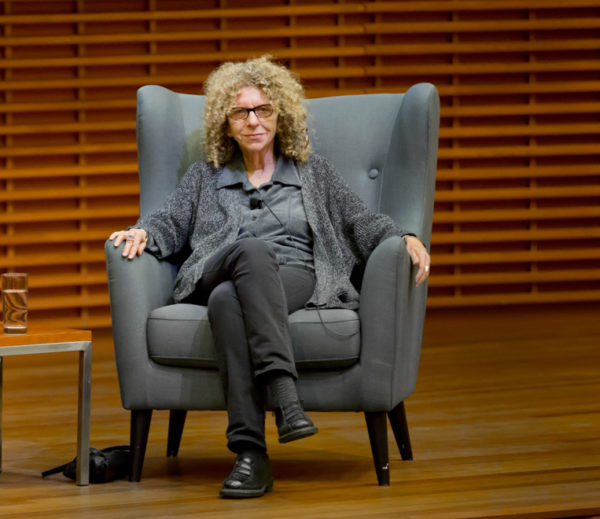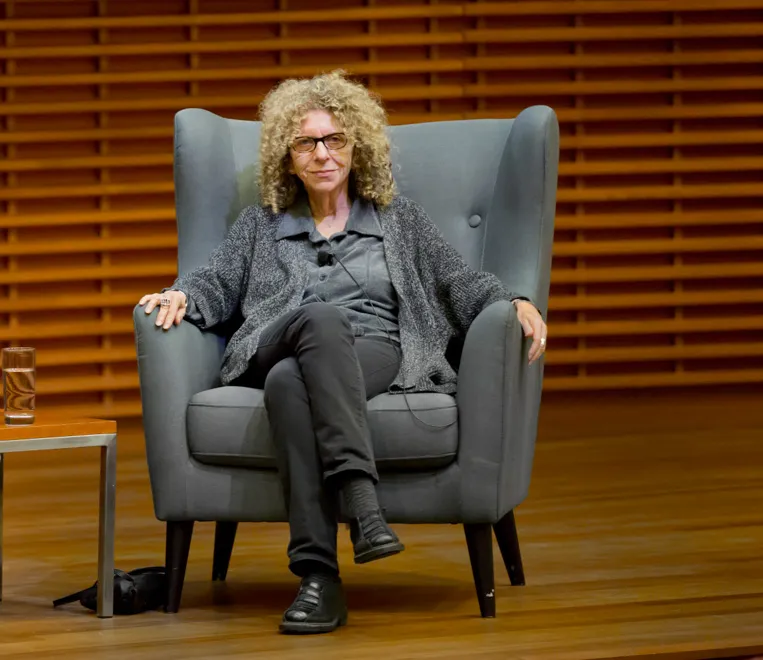
On the evening of May 16, Barbara Kruger and Alexander Nemerov graced the stage of Cemex Auditorium with a discussion about Kruger’s work and its social implications. The talk is a part of The Ethics of Democracy Series, a program whose goal is to analyze the ethics of democracy from the perspective of scholars and civil leaders across the country.
Barbara Kruger is a conceptual artist whose work deals with themes of consumerism, identity and sexuality. She plasters bold typographic elements onto buildings and photographs, leveraging the aesthetics of advertisement and editorial design. In doing so, Kruger’s work serves as an overture to these weighty themes.
Kruger’s style is influenced in part by her past experience as an editorial designer and fashion illustrator. The designer-turned-artist looks to craft meaning from images and text in concert. Within the images, the body is used as a presentational device for the text.
Alexander Nemerov, Chair of the Department of Art & Art History at Stanford, opened the conversation with an image of Kruger’s iconic piece, “Your Body is a Battleground.” The piece is meant to serve as a poster for the March on Washington for women’s reproductive rights, showcasing the ongoing presence of political undertones in Kruger’s work. The aesthetic of the piece is reminiscent of the aesthetic of propaganda for street fashion brands like New York-based Supreme.
“I love the everyday. I love the repetition of the everyday,” Kruger remarked. “I like the moments between events, and it’s during those moments that I create my work.”
Her more recent works take the form of site-specific installations, wherein Kruger works with architecture to create immersive experiences. Departing from Kruger’s earlier photographic collages, these installations forgo photographic images in favor of standalone text and a limited palette of solid colors: black, white and red.
Kruger believes her work has grown in scale because of technological allowances. Indeed, the size of her work in the gallery space is large and imposing, harmonizing with the surrounding architecture. The built environment has a huge effect on how we perceive artwork and the world around us.
Kruger’s large-scale works, such as “Belief+Doubt” in the lobby of the Hirshhorn Museum, are immersive in a way that her more traditional works arguably are not. Other works, like Kruger’s “Don’t Be a Jerk” New York billboard installation, step outside of the gallery space into more gritty urban venues.
On the topic of visual arts in society, Kruger believes the visual arts are marginalized in American culture. She cites recent cuts for arts funding in LA, musing that the visual art community is often perceived as an unfamiliar, closed culture.
For Kruger, the value of art lies in its ability to “make your life feel bigger and richer.” Art is the ability to visualize one’s experience with the world — abstracting the feeling of living and breathing. Art shows people what it means to be alive. By taking a conscious effort to crack the codes and to learn the language of abstraction and conceptual art, Kruger believes people can begin to adopt a more vibrant, examined view of the world.
Contact Eric Huang at eyhuang ‘at’ stanford.edu.
